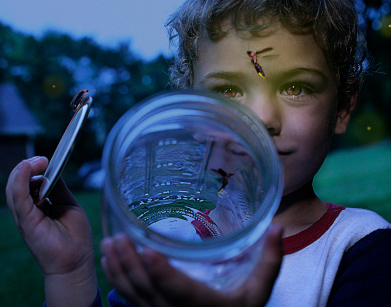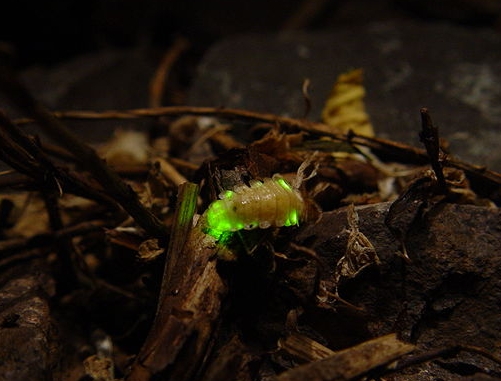
Keep in mind, if you catch a firefly, it's only got two weeks or less to live, whether you keep it in the jar or not.
(Photo from Firefly.org)
- Fireflies are actually beetles.
- There are about 2,000 different species of fireflies. Some flash off and on, some simply glow, some flash and dive to make glowing shapes in the air, and some don't glow at all.
- Fireflies prefer moist places, so they tend to live in humid climates or near bodies of water. Some Asian fireflies spend their entire lives underwater.

More species of fireflies and more of each species live in Asia. So in Asia you'll see a lot more fireflies in one place, as in this photo of a berembang tree in Malaysia that is full of fireflies.
(Photo from Malaysia Site)
- Fireflies live all across the US, but west of Kansas you'll find only the ones that don't glow. Scientists don't know why the glowing fireflies prefer the eastern part of the country.
- The glow comes from photic organs, or organs that produce light.

A good shot of the firefly's photic organ in full glow.
(Image from Catching Fireflies)
- Three special substances combine in the cells of the photic organs. The three substances are
- luciferin -- a pigment present only in fireflies and other bioluminescent creatures
- luciferase -- enzyme that acts as a catalyst
- ATP, or adenosine triphosphate -- a nucleotide that provides energy to cellular activities. We all have ATP in our cells.
- (Luciferin and luciferase, by the way, don't have anything to do with the devil. Those words mean "light bearer," not devil. So don't go making fireflies into something evil because they're not.)
- Those three substances react together to make two new substances, and then one of those meets up with oxygen, light is produced.
- What's pretty remarkable about this reaction is that nearly 100% of the energy produced is in the form of light. Hardly any of it is heat. By comparison, only 10% of a light bulb's energy is in the form of light and 90% is heat. This is why the fireflies don't overheat when their taillights keep flashing on and off.
- Scientists think that the flashing happens when fireflies control the flow of oxygen into the photic organ. When the restrict the flow of oxygen, the light shuts off. Turn on the oxygen, the light goes on.
- Speaking of the flashing, each species has a different blinking pattern. So if you see a firefly that blinks in one pattern and another one nearby that flashes a different pattern, chances are, those are two different species.
- If you watch long enough, you can pick up their blinking pattern. And if you have a penlight and blink it in the same pattern, a firefly will flash you that pattern back.
- And yes, the purpose of the blinking is so that the fireflies can find potential mates.
- Firefly mating is actually pretty intense. Fireflies live for two years underground as larvae, and then when they come up into the air as adults, they've got two weeks to live and they spend it looking for mates.
- Adult male fireflies might visit a few plants to collect nectar and pollen, but adult female fireflies don't eat at all. They're too busy looking for mates.
- The fireflies doing all the flashing are males. (No pun intended.) The females stay on the ground and watch. When they're interested in somebody, they flash a single pulse. The male will blink his pattern back, and a call & response goes on for a while.
- A female might flash her single pulse with as many as 10 males in an evening. But ultimately, she'll choose only one--the one with whom she has had the most call & response exchanges.
- How she chooses which male may have something to do with the male's ability to provide food.
- Male fireflies, like a lot of invertebrate species, produce packages of protein with their sperm. Eggs that are fertilized with sperm that has lots of protein do much better than those with less sperm-protein. So scientists think that female fireflies are interpreting the male firefly signals to try to find the males that can give them the biggest protein package.
- But firefly flashing is a subtle art. Males that flash brightest or fastest or longest are sometimes preferred by the ladies. But those superlative males are also the biggest target for their main predator, the Photuris, which pounces on fireflies, sucks the blood out of them, and casts their husks aside. So scientists think this is why some females prefer males that aren't always so flashy--they live longer.
- When a male and female firefly do hook up, they mate with each other all through the night until dawn. Then the couples will split up and the females will burrow into the grass and lay their eggs.

Fireflies mating. All night long.
(Photo from the Firefly Badminton Club in the UK)
- Firefly larvae also produce a glow. But larvae are certainly not old enough to mate. So scientists think that another purpose of the glow might be to warn potential predators that fireflies taste very bitter. (I always wonder how scientists know this sort of thing. Do they eat the fireflies themselves? And how do they know that what tastes bitter to humans will also taste bitter to birds or other bugs?)

Glowing firefly larva, or glow-worm
(Photo from Firefly.org)
- There are a few other beetles besides fireflies that are bioluminescent. Some click beetles can glow, and a few beetles in the phengodid family, as well as a few other small families of beetles.
I just want to point out a little coincidence here. The Daily Apple reader who asked me about this topic did so on my birthday. The article that is the primary source for this Apple was published on my birthday. A little synchronized glowing, yes?
Sources
National Geographic, Animals, Firefly (Lightning Bug)
Marc Branham, The Firefly Files
Onelook
Carl Zimmer, "Blink Twice if You Like Me," The New York Times, June 29, 2009
University of Utah, Why do fireflies glow?
Beautiful and fascinating science! www.satisfiedsole.com
ReplyDeleteI thought the fireflies couldn't get over the Rockies....
ReplyDeleteOnce driving down Grand River Drive at night from Pontiac to GR all the fields were full of fireflies. Especially once I got to the farms and forests I was driving in a sea of light. The air smelled damp and earthy. There was only a sliver of moon.
ReplyDeleteLast summer in Virginia, one or two fireflies would always get stuck in my room at night, and it was kind of comforting to see them fly around and glow.
ReplyDeletefireflies are very pretty when they glow! i put 2 or more on my hands! when they reach the top of my arm it tickles too much!when they flap their wings fast i quickly catch them! i am five years old.
ReplyDeleteThanks, everybody, for your delightful tales of interacting with fireflies. (Hah, I made a pun without realizing it.)
ReplyDeleteAnybody else want to contribute a firefly story?
...when I had my tonsils removed,
ReplyDeleteI think I was 6,
my sister brought her freakish Troll dolls to the hospital,
my brother brought a jar of fireflies.
The fireflies were better company.